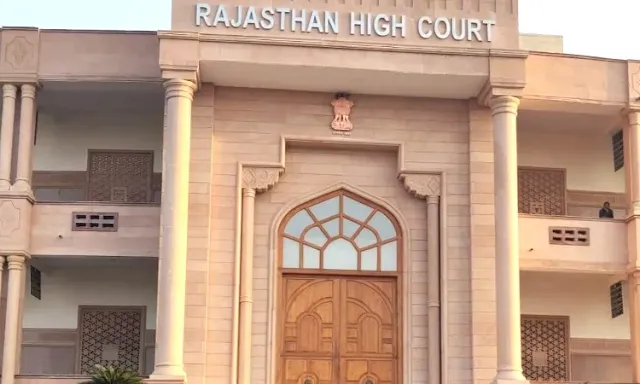The Rajasthan High Court recently delivered a significant judgment addressing the complexities surrounding disciplinary proceedings against employees working in multiple departments. The case revolved around whether a single charge sheet could be issued to an employee who faces allegations across different departments. The ruling offers clarity on procedural fairness, administrative efficiency, and the need to uphold principles of natural justice.
Background of the Case
The case emerged when an employee, associated with two distinct departments, was issued a common charge sheet addressing allegations of misconduct in both roles. The employee contested the validity of the charge sheet, arguing that it violated procedural norms and principles of fairness. The issue raised critical questions about the scope of disciplinary authority, the procedural framework for handling multi-departmental allegations, and the employee’s rights during such proceedings.
Key Issues Before the Court
1. Legality of a Common Charge Sheet
The central question was whether issuing a single charge sheet for allegations arising from different departments was legally permissible. The petitioner argued that each department should independently address the allegations, as their administrative jurisdictions and procedures differ.
2. Jurisdictional Boundaries
Another significant issue was the jurisdictional authority of disciplinary proceedings. The Court had to examine whether a single authority could oversee disciplinary actions when allegations span multiple departments with distinct hierarchies.
3. Principles of Natural Justice
The Court also evaluated whether issuing a common charge sheet undermined the employee's right to a fair hearing. It considered whether such a process might create confusion, limit the employee's ability to defend themselves effectively, or result in procedural irregularities.
Court’s Observations
Applicability of Disciplinary Rules
The Court noted that disciplinary proceedings are governed by departmental rules, which often differ in terms of scope, procedures, and applicable penalties. Combining charges from multiple departments into a single charge sheet risks procedural conflicts and potential violations of statutory provisions. The Court emphasized that disciplinary actions must adhere strictly to the rules governing each department.
Jurisdiction and Authority
The Court clarified that jurisdictional boundaries are integral to maintaining administrative order. Each department operates under distinct administrative control, and disciplinary actions should reflect this separation. The Court observed that consolidating allegations under a single proceeding could blur jurisdictional lines and compromise the autonomy of departmental authorities.
Fairness and Employee Rights
Highlighting the principles of natural justice, the Court stressed that employees must be given a clear and unambiguous opportunity to respond to allegations. A common charge sheet may confuse the employee about which department's rules apply, thereby limiting their ability to mount a coherent defense. The Court emphasized that fairness must not be compromised for administrative convenience.
Judgment and Key Directives
1. Separate Proceedings for Different Departments
The Court ruled that disciplinary proceedings must be conducted separately for each department involved. It stated that issuing a common charge sheet is not permissible, as it undermines procedural clarity and fairness. Each department must independently address allegations and adhere to its disciplinary framework.
2. Clarity in Charges
The Court directed that charges must be clearly framed, specifying the nature of misconduct and the department to which it pertains. This ensures that the employee understands the allegations and can prepare an effective defense.
3. Coordination Between Departments
While maintaining the independence of departmental proceedings, the Court acknowledged the need for coordination to avoid conflicting outcomes. It suggested that departments could share evidence and coordinate timelines, provided such actions do not compromise procedural fairness.
4. Employee Rights
The judgment reiterated that employees have the right to a fair hearing and due process. Departments must ensure that proceedings are transparent, and employees are given sufficient time and resources to respond to allegations.
Implications of the Judgment
Administrative Efficiency
The judgment strikes a balance between administrative efficiency and procedural fairness. By requiring separate proceedings, it ensures that each department adheres to its rules while avoiding procedural shortcuts that could compromise justice.
Clarity for Employees
For employees, the ruling provides clarity on their rights and the procedural framework for disciplinary actions. It safeguards them from potential confusion and ensures that they are not unfairly penalized due to procedural irregularities.
Precedent for Future Cases
The judgment sets an important precedent for handling multi-departmental disciplinary cases. It offers guidance on maintaining jurisdictional boundaries while ensuring coordination and consistency in administrative actions.
Analysis and Critique
Strengths of the Judgment
The Court’s emphasis on procedural fairness and natural justice is commendable. By requiring separate proceedings, it upholds the principles of administrative law and ensures that employees are not disadvantaged by procedural ambiguities. The judgment also highlights the importance of jurisdictional clarity, which is crucial for maintaining administrative order.
Potential Challenges
While the judgment provides clear guidelines, implementing separate proceedings for each department may increase the administrative burden. Coordination between departments, though necessary, could lead to delays and complications, particularly in cases involving overlapping evidence or witnesses.
Need for Comprehensive Guidelines
The judgment underscores the need for comprehensive guidelines to address multi-departmental disciplinary cases. Such guidelines could streamline procedures, reduce administrative burdens, and ensure consistency across departments.
Conclusion
The Rajasthan High Court’s ruling on disciplinary proceedings involving multiple departments is a significant contribution to administrative law. By emphasizing the importance of procedural fairness, jurisdictional clarity, and employee rights, the judgment reinforces the principles of natural justice and administrative efficiency. It serves as a valuable precedent for future cases, providing clear directives for handling complex disciplinary issues. As departments implement the judgment, they must strike a balance between maintaining procedural rigor and ensuring timely resolution of cases.










0 Comments
Thank you for your response. It will help us to improve in the future.